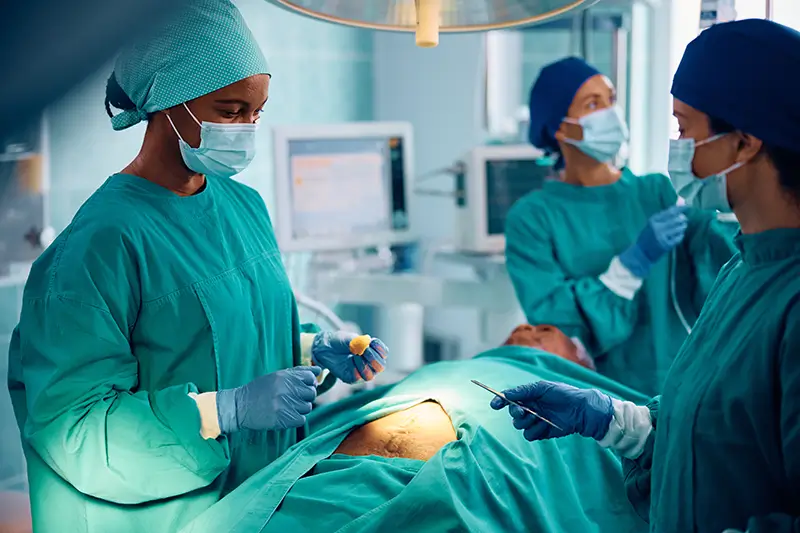A hernia occurs when an organ or tissue pushes through a weakened area in the surrounding muscle or connective tissue (fascia). This abnormal protrusion can involve an empty sac or, if the defect is large enough, may contain abdominal contents, such as part of the intestine. While most hernias are not immediately life-threatening, they do not resolve on their own. In many cases, surgical intervention is necessary to prevent serious complications.
Most health insurance plans typically cover the procedure, but pre-authorization requirements, co-pays, deductibles, and coverage limitations can vary based on the insurance company. With changing codes and varying payer guidelines, accurate medical billing and coding for general surgery procedures is a practical way to ensure accurate reporting and ensure proper reimbursement for hernia repair. This post lists the different types of hernias and the primary CPT codes for billing abdominal wall hernia repairs.
Need expert general surgery billing and coding services?
Reach out to our experienced certified coders.
Types of Hernia
Inguinal hernia – This is one of the most common types of hernia which mainly affects men. An inguinal hernia is specific to the groin area and occurs when the intestines push through a weak spot or tear in the lower abdominal wall, often in the inguinal canal.
Hiatal hernia: This condition is most common in people over 50 years old. It occurs when part of the stomach protrudes up through the diaphragm into the chest cavity.
Umbilical hernia: This condition occurs when the intestines bulge through their abdominal wall near the belly button. It is more common among babies below 6 months. This is the only type of hernia that often goes away on its own as the abdominal wall muscles get stronger, typically by the time the child becomes 1 year old.
Femoral hernia: This type occurs when fatty tissue or a part of the bowel pokes through into the groin at the top of the inner thigh.
Incisional/ventral hernia: The condition arises when tissue pokes through a surgical wound in the abdomen that hasn’t fully healed.
Epigastric hernia: It occurs when fatty tissue pokes through the abdomen, between the navel and the lower part of the breastbone (sternum).
Diaphragmatic hernia: This type of hernia occurs when organs in the abdomen move into the chest through an opening in the diaphragm. This condition can also affect babies if their diaphragm doesn’t develop properly in the womb.
Primary CPT Codes for Hernia Repair
The CPT Surgery section under Digestive System/Abdomen, Peritoneum, and Omentum/Repair apply to the anterior abdominal hernia repairs, which include epigastric, incisional, ventral, umbilical and spigelian hernias, repaired by any method or approach (open, laparoscopic, or robotic), regardless of whether the hernia is reducible or not.
The primary CPT codes for hernia repair include: 49505 for an inguinal hernia repair, 49591-49596 for incisional or ventral hernia repairs, and 49613-49618 for laparoscopic ventral hernia repairs, with specific codes depending on the size and complexity of the hernia and the type of repair performed.
- Inguinal Hernia Repair
49505 – This code is reported for the repair an initial inguinal hernia on a child, five years of age or older.
Accurate inguinal hernia coding requires careful attention to laterality, type (direct or indirect), and whether the procedure was initial or recurrent.
- Anterior Abdominal Hernia Repair
There are 12 CPT codes Codes 49591–49596 and 49613–49618 to describe repair of an anterior abdominal hernia(s) (epigastric, incisional, ventral, umbilical, spigelian), by any approach (open, laparoscopic, robotic), further by total defect size, and further by reducible or incarcerated/strangulated.
Initial – 49591-49596 Ventral or incisional hernia
49591 Repair of anterior abdominal hernia(s) (i.e., epigastric incisional, ventral, umbilical, spigelian), any approach (i.e., open, laparoscopic, robotic), initial, including placement of mesh or other prosthesis, when performed, total length of defect(s); less than 3 cm, reducible
49592 Less than 3 cm, incarcerated or strangulated
49593 3 cm to 10 cm, reducible
49594 3 cm to 10 cm, incarcerated or strangulated
49595 Greater than 10 cm, reducible
49596 Greater than 10 cm, incarcerated or strangulated
Proper ventral hernia repair billing involves selecting the correct CPT code based on the size and complexity of the hernia, as well as documenting mesh placement and any additional procedures performed.
Recurrent – 49613-49618 Laparoscopic hernia repair
Repair of recurrent hernias are usually complex and a plastic surgeon may be also involved to address attenuated or absent tissues.
49613 Repair of anterior abdominal hernia(s) (i.e., epigastric incisional, ventral, umbilical, spigelian), any approach (i.e., open, laparoscopic, robotic), recurrent, including placement of mesh or other prosthesis, when performed, total length of defect(s); less than 3 cm, reducible
49614 Less than 3 cm, incarcerated or strangulated
49615 3 cm to 10 cm, reducible
49616 3 cm to 10 cm, incarcerated or strangulated
49617 Greater than 10 cm, reducible
49618 Greater than 10 cm, incarcerated or strangulated
Reporting Anterior Abdominal Hernia Repair: Points to Note
- For 49591-49596, 49613-49618, code selection is based on the size of the repair(s). The size is reflective of the total defect size reported.An AAPC article explains how size of repair(s) should be measured: “The physician should take the farthest points of the hernia (top to bottom or side to side) of the defect (not sac) to generate the measurement. If two or more hernias are separated by 10 cm or more of intact fascia, then the physician should measure each hernia separately and add the sizes together”.
- When both reducible and incarcerated/strangulated anterior abdominal hernias are repaired at the same operative session, all hernias are reported as incarcerated/strangulated.
- Inguinal, femoral, lumbar, omphalocele, and/or parastomal hernia repair may be separately reported when performed at the same operative session as anterior abdominal hernia repair by appending modifier 59, Distinct Procedural Service, as appropriate.
- For the anterior abdominal family of codes, all procedures and services performed beginning the day after the surgery should be separately reported, including hospital visit E/M codes 99231–99233, discharge management codes 99238–99239, office visit E/M codes 99211–99215 (in-person or via telehealth, as allowed), and any other E/M services code, when appropriate, such as telephone E/M codes 99441–99443, online digital E/M codes 99421–99423, or principal care management codes 99424–99427.
- Global period: The primary anterior abdominal hernia repair codes have a global period of 0 days, which allows correct reporting of hospital and office E/M visit codes in the postoperative period. For example, the American College of Surgeons (ACS) explains that, if the patient stays overnight and is discharged the next day:
- Report CPT code 99238 or 99239 for discharge management on the day after the procedure.
- If the patient is admitted and stays 5 days in the hospital, report an inpatient E/M visit code for each hospital day that a visit occurs.
Since the codes have a 0-day global assignment, additional procedures (wound debridement, suture/staple removal) are separately reportable even if the procedure does not require a return to the operating room (OR).
- Parastomal Hernia Repair
49621 Repair of parastomal hernia, any approach (i.e., open, laparoscopic, robotic), initial or recurrent, including placement of mesh or other prosthesis, when performed; reducible
49622 Incarcerated or strangulated
Mesh Removal
For total or near-total removal of non-infected mesh, report add-on code 49623 in conjunction with 49591–49596, 49613–49618, and 49621–49622.
+49623 Removal of total or near-total non-infected mesh or other prosthesis at the time of initial or recurrent anterior abdominal hernia repair or parastomal hernia repair, any approach (i.e., open, laparoscopic, robotic) (List separately in addition to code for primary procedure)
- Implantation of mesh or other prosthesis, when performed, is included in 49591–49596, 49613–49618, and 49621–49622 and may not be separately reported no matter the approach (open, laparoscopic, robotic).
- The codes for removal of infected mesh (debridement of Necrotizing Soft Tissue Infections) are: 11004, 11005, 11006, and 11008. CPT codes 11004-11006, and 11008) are inpatient only procedure codes.
Related Codes
- Implantation of Mesh for Delayed Closure
15778 Implantation of absorbable mesh or other prosthesis for delayed closure of defect(s) (i.e., external genitalia, perineum, abdominal wall) due to soft tissue infection or trauma
(Code 15778 has a 0-day global period and may be reported with or without other procedures performed at the same operative session).
- Removal of Sutures and/or Staples “In the Office”
In 2023, two new add-on codes were established for reporting suture and/or staple removal in conjunction with an E/M visit:
+15853 Removal of sutures or staples not requiring anesthesia (List separately in addition to E/M code)
+15854 Removal of sutures and staples not requiring anesthesia (List separately in addition to E/M code)
Codes 15853 and 15854 may be reported with an appropriate E/M service for any procedure that has a 0-day global period, including the new anterior abdominal hernia repair codes.
As these add-on suture/staple removal codes are for practice expense reimbursement only (i.e., clinical staff time, disposable supplies, and use of equipment), they do not have physician work relative value units (RVUs) assigned.
The codes may be reported multiple times, but only once per day. Here’s an example from the ACS: “On postop day 3 after a 0-day global procedure is performed, code 15853 can be reported for suture removal related to drain removal. Then, on postop day 10, code 15853 can be reported again with an appropriate E/M for staple removal. Since codes 15853 and 15854 are add-on codes to be reported with an E/M code, no modifier should be appended to the E/M code”.
- Removal of Sutures or Staples “Under Anesthesia”
For removal of sutures or staples requiring anesthesia (i.e., general anesthesia, moderate sedation), report:
Code 15851 Under Other Repair (Closure) Procedures on the Integumentary System
Code 15851 describes the procedure for the removal of sutures or staples that requires anesthesia. This code is used when the removal process is more complex and cannot be comfortably or safely performed without the use of anesthesia. This might be necessary if the sutures or staples are deeply embedded or if the removal process causes significant discomfort or pain.
Using the appropriate modifier with code 15851 helps provide additional information about the circumstances under which the procedure was performed, ensuring accurate billing and reimbursement.
For example, if complications or other factors increased the complexity of the procedure, adding Modifier 22 Increased Procedural Services will show that the procedure required significantly more work than typically needed.
Key Considerations when Documenting and Coding Hernia Repair
- Documentation
The role of documentation in accurate general surgery coding is critical, as clear, detailed operative notes help coders assign precise codes that reflect the complexity and scope of the surgical procedure. When describing a hernia defect, it’s important to specify: – its size (small, medium, large). The total size of a hernia defect should be reported correctly, as this impacts the total physician work. List the following:
- The number of defects present (single or multiple)
- Type of hernia – epigastric, hiatal, inguinal, incisional, femoral, ventral, and so on
- Surgical method – open surgery or laparoscopic
- Primary or recurrent hernia
- Whether hernia is incarcerated or strangulated
- If mesh placement was involved
- Payer policies
- Most health insurance plans include coverage for hernia repair surgery, including both inguinal and incisional hernias.
- Many insurers require prior authorization before a hernia repair surgery can be performed. Insurance eligibility check and authorization is key to confirm the process.
- Policies may have different coverage levels depending on the type of hernia repair needed, such as laparoscopic versus open surgery.
Staying up to date with the latest CPT codes and billing guidelines is essential for accurate reporting and maximizing reimbursement. Medical billing and coding companies employ AAPC-certified coders who are well-versed in the most current CPT and ICD-10 codes for a wide range of surgical procedures. Partnering with a company providing specialized revenue cycle management for general surgical practices is the best option to ensure precise coding, smooth claim submissions, and optimal reimbursement.
Ensure precise general surgery coding and maximize your reimbursements.




